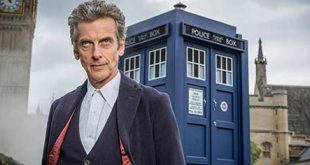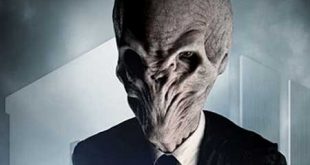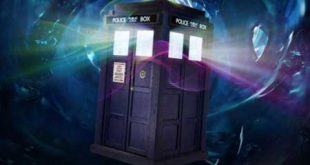Original broadcast date: 23 November – 14 December 1963
STORY ARC #001: 4 episodes: An Unearthly Child / The Cave of Skulls / The Forest of Fear / The Firemaker

Synopsis: Two teachers at Coal Hill School who are concerned for the welfare of one of their pupils – a precocious but artless girl called Susan – follow her after school to her home address, which turns out to be a run-down scrapyard. Inside the gates amid piles of junk they discover a police telephone box which appears to be humming with power. Startled by the sudden appearance of an old man, they demand to know where Susan is but the old man is hostile and obstructive. However, they hear Susan’s voice coming from inside the phone box and barge their way in. They discover to their shock that the box is not only full of the most incredible technology but it is also bigger on the inside than it is on the outside. Susan attempts to explain that she and her grandfather are alien beings from far in the future and that the phone box – which she calls the TARDIS – is their ship, capable of traveling through both space and time. The dumbstruck teachers refuse to accept such claims and demand to be allowed to leave but the old man, who refers to himself as ‘the Doctor’, refuses, asserting that they cannot be permitted to return to Earth now that they have glimpsed the future. The Doctor programs the TARDIS to leave; it dematerializes from the scrapyard and reappears on what appears to be an Earth-like planet in the Stone Age…
Review: So this is where it all begins. It is hard to imagine how strange this program must have appeared to television audiences of 50 years ago. Right from the off even the titles and theme tune are out of the ordinary: strange pulsing and distorted lights and even stranger electronic music. Both instantly suggest something that is alien.

Contrast then that feeling of otherness with the first images we see: a policeman on his nightly patrol – something familiar, recognizable, perhaps even reassuring. However, after he has moved along, the prowling camera makes us realize that there is something not quite right going on behind the locked gates of the scrapyard. This contrast of the familiar and the alien figures throughout the opening episodes and another instance of it occurs in the next sequence, at a secondary school.

Teachers Ian Chesterton (William Russell, who had a small role in THE GREAT ESCAPE) and Barbara Wright (Jacqueline Hill) are having a good natured whinge at the end of another tough day. Their conversation turns to observations they have both made about the ‘oddness’ of one of their pupils, Susan Foreman (Carole Ann Ford). Chesterton remarks that Susan is exasperated by the elementary level of experiments he has asked his pupils to conduct in a chemistry class; Wright recalls how Susan thought Britain used the decimal monetary system (in 1963 Britain still used the imperial system; the decimal system was not adopted until 1971).

The opening titles and theme tune having set the audience up to expect strange things to occur, the teachers’ comments about Susan are leading us to speculate that she may possess abnormally high intelligence which in turn means we can’t assume her ignorance of the British currency is merely stupidity. Indeed, we recall the title of the episode we are watching and may even begin to suspect that Susan may not be human.
There is an interesting exchange between the teachers as they wait in their car for Susan’s arrival home after school. Chesterton suggests that were it not for the fact that they too suspect there is something mysterious about this girl, and were it not for the fact they are both sufficiently intrigued to want to satisfy their curiosity, neither of them would be sitting in that car at that moment. What this implies is that both possess a spirit of inquiry, a sense of adventure if you like that effectively makes them surrogates for the audience: they are willing to go where the audience wants to go too. This, I believe, is a central feature of Doctor Who and one which is a cornerstone of its success. It also explains why the Doctor has almost always been accompanied on his adventures by ordinary human beings: for the fantastic to seem real to us, it has to be witnessed or experienced by someone we can identify with and whose reactions we can understand. For the time being, this function will be performed by Chesterton and Wright.
Perhaps even more so than in later series, these human companions were essential with the first Doctor (William Hartnell) because in this opening story arc he is, frankly, not a very likeable man. When he appears for the very first time on British TV screens he is a hostile, rude and unhelpful old man; once he is inside the TARDIS with the two earthling teachers he becomes downright threatening, possible even murderous. So this is our first impression of the Doctor and it is not favorable, to say the least. However, you have to bear in mind that much of science fiction – particularly in film and on television – at this time posited the idea that aliens from other worlds would almost certainly be hostile.

I love the fact that the writers of Doctor Who were brave enough to make the Doctor such an obnoxious character and to include a sequence in the opening episode of their new show which features him abducting and perhaps even threatening to kill two humans. The horror / sci-fi director Stuart Gordon once remarked that he loved working in genre films because so long as you obeyed certain basic rules you were pretty much free to do as you pleased. What I think he means is that working in genre films allows you, should you be so inclined, the freedom to say and do things that you wouldn’t get away with in mainstream cinema. And by that I don’t mean plot devices like time travel or monsters; I mean really taking chances with your characters, or the themes your stories deal with, and I think Doctor Who has over the years been a prime example of that and indeed started off very much in that vein.

I must confess that this four-part story arc does go considerably off the boil about mid-way through the second episode. Once the TARDIS has gone back in time to the Stone Age, the story becomes rather bogged down: the Doctor, Susan and the two teachers are taken prisoner by some cavemen and becomes pawns in a war of succession between two rivals for leadership of the clan. During the course of the adventure, the modern-days humans demonstrate their courage and resourcefulness to the Doctor while managing to introduce such concepts as mercy and compassion to their ancestors. Similarly, the Doctor reveals himself to be a highly intelligent and insightful, if somewhat impatient and crotchety. Beyond that, however, this story arc reveals very little information about the Doctor and who, or what he really is.

Looking at these black-and-white episodes fifty years down the line, they do seem crude but despite that they’re still enormously inventive and terrifically watchable. The contrast between the familiar and the alien, ancient and modern, young and old is skilfully done and there is a neat parallel drawn between the companions’ awe and even fear of the Doctor and his futuristic technology and that of the Stone Age tribes’ similar attitude towards the technology they can barely comprehend – fire. The four episode story arc lays down a format which the series followed almost invariably until the recent reboot; that is to say, roughly 25-minute episodes, each of which ends on a cliff-hanger that is resolved at the beginning of the following episode. In doing so, the series follows in the proud tradition of those old Buster Crabbe ‘Flash Gordon’ serials of the 1930s. And, at the conclusion of the story arc, there is the promise of a completely new adventure to follow which, given the abilities of the TARDIS, could literally be anywhere in time and space. Now what self-respecting child (or young-at-heart adult) could possibly resist that? NEXT MONTH – STORY ARC #002: THE DALEKS

The Doctor Who Project: An Unearthly Child
 Horror News | HNN Official Site | Horror Movies,Trailers, Reviews
Horror News | HNN Official Site | Horror Movies,Trailers, Reviews




